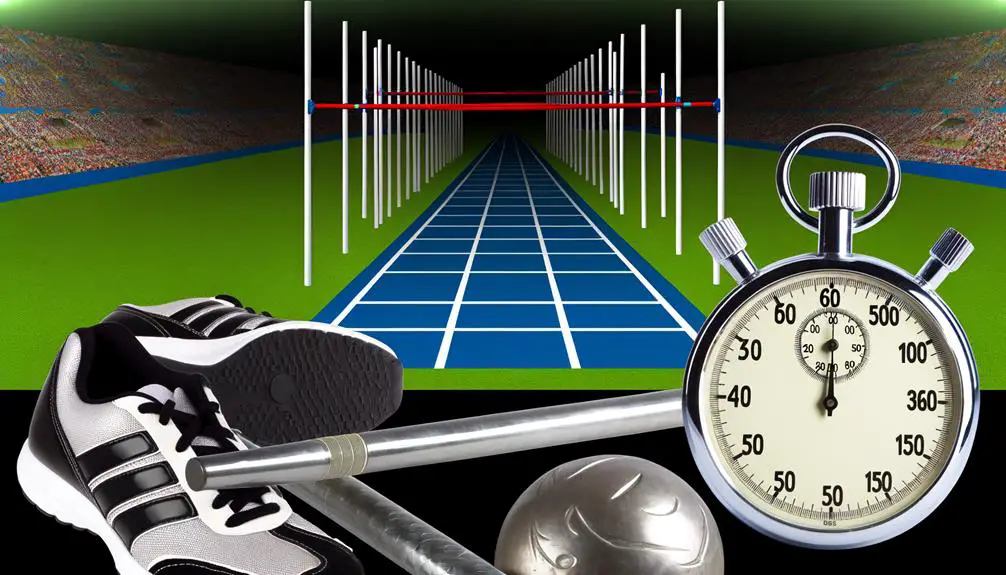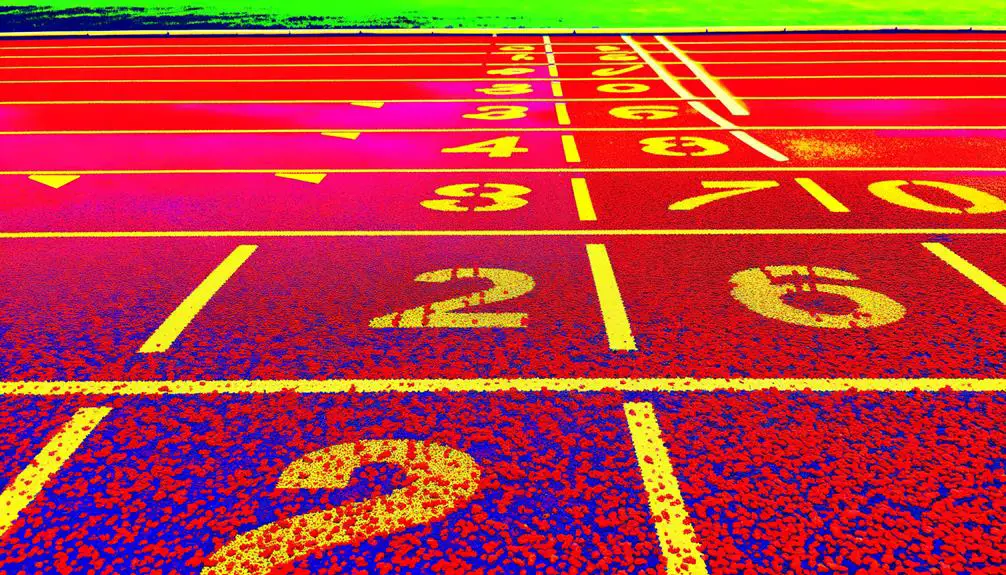Decoding Track and Field Symbols – A Guide to Their Meaning
Track and field symbols carry deep meaning integral to the sport's structure and spirit. Lane numbers and starting lines determine positioning and techniques essential for a balanced start.
Crossing the finish line marks personal triumphs and achievements. Relay batons represent teamwork and precise coordination.
Hurdle and jump pit markings guarantee fairness and accuracy, while event flags and uniform colors provide essential communication, identification, and safety. Throwing sector lines define angles for various throws.
Each symbol guarantees the competition is fair, organized, and inspiring. Discover more about how these symbols contribute to the excitement and discipline of track and field.

Key Takeaways
- Finish Line: Represents completion, triumph, and achievement, marking the end of a race and the realization of goals.
- Relay Baton: Symbolizes teamwork, trust, timing, and cooperation among relay team members.
- Event Flags: Used for communication and ensuring fairness during events, with colors like red, white, yellow, and checkered.
- Uniform Colors: Denote nations, aid athlete identification, and enhance visibility, contributing to safety and organization.
- Track Surface Markings: Include lane numbers, start/finish lines, and relay exchange zones, essential for event organization and execution.
Lane Numbers

Lane numbers in track and field events serve as vital identifiers, designating the specific starting positions for each competitor. These numbers, typically ranging from one to eight or nine, are strategically assigned to guarantee fair competition.
Lane assignments are often determined by preliminary heats or qualifying times, guided by regulations that vary by event and governing body. The outer and inner lanes present distinct advantages and challenges; inner lanes offer tighter curves but shorter distances, while outer lanes provide wider turns but longer travel. Athletes must familiarize themselves with their assigned lanes to optimize performance.
Starting Line
The starting line in track and field is not just a mark on the ground; it represents the crucial juncture where positioning, starting block techniques, and psychological preparation intersect to influence performance.
Athletes must understand the significance of their stance and the mechanics of their blocks to maximize their launch. Equally important is the mental readiness, which can greatly impact their reaction time and overall success.
Importance of Positioning
A runner's position at the starting line can greatly impact their performance and overall race strategy. The alignment and stance adopted before the race begins are vital for gaining an immediate advantage. Proper positioning guarantees that athletes can maximize their initial acceleration and maintain peak form throughout the race.
- Balance: Maintaining equilibrium prevents false starts and ensures a solid launch.
- Alignment: Correct body alignment minimizes energy wastage and enhances efficiency.
- Comfort: A comfortable stance helps reduce stress and potential muscle strain.
- Focus: Proper positioning aids in mental concentration, essential for a strong start.
Understanding these aspects enables athletes to enhance their starting performance, setting the stage for a potentially successful race.
Starting Block Techniques
Mastery of starting block techniques is essential for maximizing a sprinter's explosive power and ensuring a peak launch. Proper alignment and positioning in the blocks are fundamental. Sprinters should guarantee their back knee is placed on the ground adjacent to the front foot, providing a solid base.
The hands should be evenly spaced, just behind the starting line, with fingers arched. At the command 'set,' athletes must lift their hips slightly higher than their shoulders, engaging core muscles for stability. The push-off phase demands a powerful, simultaneous extension of both legs, propelling the sprinter forward.
Consistent practice of these techniques fosters muscle memory and enhances reaction time, vital for achieving best performance off the blocks.
Psychological Preparation Tips
While physical techniques are crucial, mental fortitude at the starting line can greatly impact a sprinter's performance. The psychological preparation of an athlete sets the tone for a successful race. Developing a focused and calm mindset can help alleviate pre-race anxiety and improve reaction times.
Here are some effective tips:
- Visualization: Mentally rehearse the race, from the start to the finish line, to build confidence and reduce uncertainty.
- Controlled Breathing: Practice deep breathing techniques to maintain calmness and focus.
- Positive Self-Talk: Use affirmations to strengthen self-belief and ward off negative thoughts.
- Routine Establishment: Develop a consistent pre-race routine to create a sense of normalcy and control.
Adopting these strategies can greatly enhance performance and ensure a strong start.
Finish Line

The finish line in track and field represents both a symbol of achievement and the culmination of the race. Crossing this line signifies the athlete's completion of the event, marking a moment of triumph and the end of their exertion.
It stands as a definitive point where effort and perseverance are recognized and celebrated.
Symbol of Achievement
Crossing the finish line in track and field symbolizes the ultimate achievement and culmination of an athlete's dedication and hard work. It represents not just the end of a race, but the fulfillment of countless hours of training, perseverance, and mental fortitude.
The finish line is more than just a physical marker; it embodies the essence of accomplishment and the reward for enduring effort.
- Recognition of Excellence: It signifies an athlete's exceptional performance and skill.
- Milestone of Progress: It marks a significant point in an athlete's career and personal growth.
- Source of Inspiration: It motivates other athletes to push for their goals.
- Moment of Triumph: It captures the emotional and physical victory over personal and competitive challenges.
Such symbolism underscores the profound impact of reaching the finish line.
End of Race
Marking the culmination of an athlete's effort and endurance, the finish line serves as a definitive endpoint in a race, encapsulating the essence of competition and achievement. It symbolizes the completion of a journey marked by preparation, strategy, and determination.
Crossing the finish line not only signifies the end of physical exertion but also represents the realization of goals and personal triumphs. The tape or marked line on the track offers a tangible target, a point where time stops and results are solidified.
In the split second an athlete crosses the finish line, years of training and dedication are distilled into a single moment of victory or reflection, underscoring the profound significance of this pivotal race element.
Relay Baton
In track and field, the relay baton serves as an essential element in relay races, symbolizing teamwork and precision. This small, cylindrical object is more than just a piece of equipment; it represents the seamless coordination required to achieve victory.
The baton is pivotal to the success of the team, as it must be passed within a designated exchange zone without dropping or fumbling.
Key aspects of the relay baton include:
- Material: Typically made of lightweight aluminum or plastic.
- Dimensions: Standard length of 28-30 cm and diameter of 4 cm.
- Rules: Must be exchanged within a 20-meter zone.
- Significance: Embodies trust, timing, and cooperation among team members.
Understanding these elements emphasizes the importance of the relay baton in relay races.
Hurdle Markings

Just as the relay baton represents teamwork in track and field, hurdle markings play a crucial role in guaranteeing the accuracy and fairness of hurdle races.
These markings are precisely positioned on the track to indicate the placement of each hurdle, guaranteeing uniformity across all lanes. The markings help athletes gauge their strides and maintain rhythm, critical for peak performance.
Additionally, they guide officials in the correct placement and height of hurdles, thereby preserving the integrity of the race. Clear and accurate hurdle markings reduce the risk of disputes and ensure that all competitors face the same conditions, promoting fairness and standardization in the sport.
This meticulous attention to detail is essential for both the athletes' performance and the event's credibility.
Jump Pit Indicators
Jump pit indicators are vital for ensuring accurate measurements and safe landings in track and field events like the long jump and triple jump. These indicators serve multiple functions, providing both athletes and officials with significant information.
Key elements include:
- Take-off Board: Marks the point where athletes must initiate their jump, ensuring consistency and fairness.
- Measurement Markers: Placed along the side of the pit to facilitate precise distance recording.
- Foul Line: Indicates if the athlete has overstepped, nullifying the jump.
- Landing Pit: Filled with sand to cushion landings and mark the exact spot of contact.
These elements are essential for maintaining the integrity and safety of jumping events, allowing for fair competition and accurate performance tracking.
Throwing Sector Lines

Why are throwing sector lines crucial in track and field events? These lines define the legal area within which a throw must land to be considered valid. They guarantee fairness and consistency across competitions, providing clear boundaries for officials and athletes. The sector lines are typically marked at specific angles from the throwing circle or arc, depending on the event, such as shot put, discus, javelin, or hammer throw.
| Event | Sector Angle (Degrees) | Purpose |
|---|---|---|
| Shot Put | 34.92 | Defines valid landing area |
| Discus | 34.92 | Ensures uniformity in measurement |
| Javelin | 28.96 | Maintains competition fairness |
| Hammer Throw | 34.92 | Standardizes competition area |
| Combined Events | Varies | Adjusts for event specifics |
Event Flags
Event flags play a pivotal role in track and field competitions by providing visual cues that signal the status and rules of various events. These flags ensure both athletes and officials can communicate effectively, maintaining the smooth operation of events.
Here are some key types of event flags:
- Red Flag: Indicates a foul or disqualification in events like long jump or javelin.
- White Flag: Confirms a legal attempt or successful completion of an event.
- Yellow Flag: Used to signal a potential infraction that requires further review or caution.
- Checkered Flag: Marks the end of a race or signifies that event timing is complete.
These flags are indispensable tools that uphold fairness and clarity in competitions.
Uniform Colors

Uniform colors in track and field competitions are not merely for aesthetic appeal but serve to distinguish teams, countries, and roles within the event. Athletes representing their nations don uniforms in national colors, fostering a sense of unity and pride.
Team uniforms, often featuring school or club colors, enable quick identification during relays and group events. Additionally, specific colors can denote roles such as officials or volunteers, ensuring smooth event operation.
Beyond identification, uniform colors can signal affiliations, enhance visibility, and even boost psychological performance through color psychology. Overall, the strategic use of uniform colors contributes significantly to the organization, safety, and spirit of track and field competitions, reinforcing the importance of visual differentiation on the field.
Track Surface Markings
Track surface markings play a vital role in the organization and execution of events, providing clear visual cues for athletes and officials.
Key elements include:
- Lane number indicators, which help runners identify their designated paths
- Start/finish line signage, essential for timing and race integrity
- Relay exchange zones, which guarantee smooth baton handovers
Understanding these markings is essential for both participants and spectators to appreciate the nuances of track and field competitions.
Lane Number Indicators
Often found on the inner edge of each lane, lane number indicators are important for helping athletes identify their designated starting positions on the track. These markings provide clear visual cues, ensuring that each competitor remains in their assigned lane throughout the race.
Proper understanding and utilization of lane number indicators can have a significant impact on race organization and fairness. Here are key aspects of lane number indicators:
- Visibility: Designed to be easily seen by athletes and officials.
- Positioning: Placed at regular intervals along the track.
- Consistency: Uniform across all lanes to prevent confusion.
- Durability: Made from materials that withstand weather and wear.
Understanding these elements is vital for athletes, coaches, and officials to maintain the integrity of track events.
Start/Finish Line Signage
Clear and precise start/finish line signage is critical for signaling the beginning and end of races, guaranteeing accurate timing and fair competition. These markings, typically white and located perpendicular to the lanes, serve as the definitive reference points for athletes, officials, and timing systems.
The start line must be clearly visible, often accompanied by staggered lines for races with different starting positions. The finish line is equally important, often marked with a broader, more prominent line to guarantee visibility from various angles.
Proper maintenance of these lines is essential to prevent fading, which could lead to timing discrepancies and disputes. Essentially, these markings are foundational elements in track and field, ensuring races are conducted with integrity and precision.
Relay Exchange Zones
Relay exchange zones are crucial areas marked on the track where baton transfers occur during relay races, ensuring smooth and efficient exchanges between team members. These zones are critical for maintaining the flow and momentum of the race.
Typically, each exchange zone spans 20 meters and is clearly demarcated with distinctive lines and markings. Understanding these zones is essential for athletes and coaches aiming for top performance.
Key points about relay exchange zones:
- 20-meter length: Each zone is precisely measured to facilitate proper baton handoffs.
- Distinctive markings: Lines and colors differentiate exchange zones from other track markings.
- Strategic positioning: Zones are placed to maximize speed and efficiency during baton transfers.
- Rule compliance: Proper exchange within the zone is mandatory to avoid disqualification.
Conclusion
In examining the symbols of track and field, one sees a tapestry woven with the precision of Da Vinci's sketches and the rigor of Newtonian mechanics. Lane numbers, starting lines, and uniform colors form a lexicon of competition and excellence.
From the relay baton to the hurdle markings, each element contributes to a narrative of athletic prowess and meticulous planning. This symbology underscores the sport's blend of individual effort and collective achievement, echoing the timeless pursuit of human limits.






